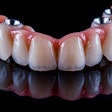
Using daylight for shade matching may not always be the best option. Getting a second opinion from a young, female dental assistant may help you achieve a perfectly matched crown. And as for that blue card you use for eye relaxation, it may be time to rethink it.
These are a few of the tips from Thomas Ziemiecki, D.D.S., an associate professor of prosthodontics at the University of North Carolina at Chapel Hill whose recent seminar at the Chicago Dental Society Midwinter Meeting was full of advice on how to achieve better shade matching.
Dr. Ziemiecki opened his presentation by showing a slide of a woman who had beautiful teeth with some subtleties when it came to shades. The central incisors were the brightest, with more color saturation in the canines, while the lateral teeth had the least amount of chroma.
"And that's what we are looking to achieve," he said. "The difference in color of natural teeth and not a monochromatic color."
When taking shades, two tools are at a dentist's disposal -- the human eye and shade guides -- explained Dr. Ziemiecki before discussing the role and importance of both.
As we age, our eyes can get old and look at objects with brownish tints, he noted. Most of the retina is composed of rods that see black and white. The eye has much fewer cones that see color, and that is why eyes are more sensitive to black and white. Women have a greater percentage of photoreceptor cells (cones) than men and can see color better, according to Dr. Ziemiecki.
"That is why it is helpful to get an opinion from a young female assistant who does not suffer from the age-induced brownish tints and also has the gender-induced advantage of more cones," he said.
Techniques to relax the eyes
Most dentists are told to keep a blue card in their office so they can look at it and relax their retinas before taking a shade, Dr. Ziemiecki said.
He then showed a slide of a black dot surrounded by different color boxes. When he removed the color boxes from around the black dot, the area covered by the blue box appeared a little yellow.
"Literature says blue fatigue increases sensitivity to yellow, so blue does not work," he said. "If you use this technique, you will tend to select something toward a yellow shade."
But dentists do need to have something in the operatory to relax the eyes, especially if they are taking shades at the end of an appointment, Dr. Ziemiecki added.
Instead of the blue card, he suggested using an 18% photographic gray card or gray construction paper with no color to relax the saturated receptors in the retina.
Also, peripheral information can affect our choice of shade -- even lipstick can change shade perception, Dr. Ziemiecki said. He suggested separating all the teeth by putting borders around them and making the individual teeth stand out more. Isolating the tooth can help achieve a more accurate idea of color for a better shade match, he said.
The role of light
Students in dental school are told to use natural daylight to select shades. But natural daylight is subject to constant change, and that is why shade selection should not depend on natural light, Dr. Ziemiecki said.
So what light should you use to select shades?
"Dental students are taught never to use dental light for shade selection, and that is absolutely the case with a light at full power," he said. "However, now you can dim the light, calibrate it, and, since a lot of lights have the ability to do that, now it is an option to explore."
Dr. Ziemiecki gave the example of the Kavolux light from KaVo Dental, which can give a color temperature of 5500 Kelvin, the same as daylight. In this case, the manufacturer claims that they have used the physics definition of natural daylight in their dental light, he said.
Hue, chroma, value, and translucency
When shade matching, most dentists look for hue, chroma, and value. Hue is the individual color of the object, chroma is the intensity of the hue, and value is the lightness or darkness of an object. Translucency is the fourth dimension of color in dentistry, and this information should also be conveyed to a lab, Dr. Ziemiecki said.
"Dentists usually don't mention the patient's age, but it can help define the level of translucency for the lab," he said. "With age, the translucency of teeth decreases. A lab should know the age of a patient because younger patients have more translucent teeth."
Shade guides
|
Some shade-matching tips
|
Every manufacturer makes their own shade guide, which means the guides vary, Dr. Ziemiecki noted. For example, there is no standard A1 shade. Dr. Ziemiecki suggested that if you have a good shade tab, send it to the lab and tell them to use it. It gives the lab a little more information so they can produce results that are closer to the particular shade you have in mind, he said.
Another thing to think about while sending shade tabs to the lab is if the lab has a porcelain material that matches that shade guide.
"It would help to call your lab and say, 'I will be using the Vident shade guide. Do you have porcelains that match that guide?' " Dr. Ziemiecki explained. If they don't, he suggested not using that guide. Instead, find out what ceramic materials they use and use the appropriate shade guide.
Dr. Ziemiecki also gave tips for getting optimal use out of the Vita classic shade guide. He recommends the following sequence for using the Vita guide:
- Select value.
- Select hue.
- Select chroma.
The classic Vita shade guide is arranged by groups: A's, light to dark; B's, light to dark; and C's, light to dark. Dr. Ziemiecki suggested rearranging the order by value (since that is what our eyes are most sensitive to) and going from the lightest to the darkest shades.
"If you are going to set them up by value, you need to not look at the ABC aspect of it," he explained. "Look at the value aspect."
Also, turn the teeth on the shade guide upside down so you can look at them incisor edge to incisor edge, he suggested. This approach eliminates the need to swipe the entire shade guide against a patient's teeth to find a match. Simply find a value in the middle of the shade guide and see if the tooth you are trying to match is lighter or darker than that shade.
"This process will automatically cut down the shade options to half, and 80% of the time a good value match is all you will need to do," Dr. Ziemiecki said.
If you need to further define the shade, pick up a shade guide that is still divided into A, B, and C groups, cut off the gingival necks of the tabs, and select hue. If you need to fine-tune any more, look for chroma.
However, Dr. Ziemiecki said he very rarely needs to use the last two steps.
"When in doubt, always go with the lighter shade (higher value), as patients usually find it more acceptable," he said. "If the shade does not match, it is easier to stain down and lower value than the other way around."
Copyright © 2010 DrBicuspid.com



















